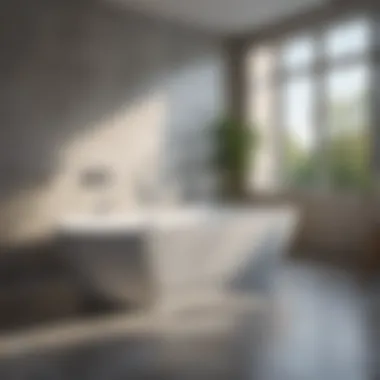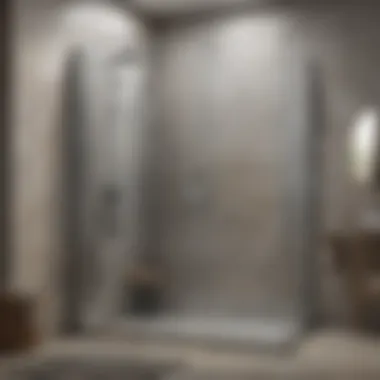Understanding Typical Bath Dimensions for Optimal Design


Intro
Creating a bathroom that balances function and style can be a tricky endeavor. The dimensions of your fixtures—like bathtubs, showers, and vanities—play a critical role in achieving that balance. Understanding typical bath dimensions allows homeowners to make informed decisions that cater to both practical needs and aesthetic desires. Whether you are renovating an old space, or designing a new bathroom from scratch, knowing what options are out there can significantly streamline the process.
Trending Styles
Modern Minimalism
Modern minimalism embraces simplicity and functionality. The dimensions often reflect this approach, favoring clean lines and open spaces. For instance, a typical bathtub in a modern minimalist bathroom might measure around 60 inches long by 30 inches wide, which promotes an uncluttered vibe. Shower stalls, often just 30 by 30 inches, create a seamless flow, allowing for greater movement within the space.
Those who love this style tend to opt for vanities with sleek profiles, usually ranging from 30 to 48 inches in width, often leaving ample floor space. The key here is to maximize functionality while maintaining a visually spacious environment.
Cozy Rustic
Contrasting with the modern approach, the cozy rustic style brings warmth and texture to a bathroom setup. Here, dimensions can vary widely, depending on the materials used. For example, a standalone soaking tub might stretch around 66 inches, creating a statement piece amidst wood accents and earthy tones.
Shower dimensions in a rustic setting may blend into a larger wet space, often around 36 by 48 inches, allowing for a feeling of immersion in nature. Vanities echo the rustic charm, often incorporating reclaimed wood, with dimensions commonly between 36 and 60 inches.
Color Palettes
Calming Neutrals
When it comes to colors, calming neutrals reign supreme. Shades like soft whites, grays, and beiges create a serene backdrop that enhances natural light, making small bathrooms feel larger. These hues pair well with standard sizes; think a compact 60-inch tub framed within a spacious, light-hued bathroom.
Bold Accents
Alternatively, bold accents can give a bathroom personality. Using deeper tones on vanities or as accent walls allows smaller fixtures to pop. A standard 30-inch vanity in navy blue can dramatically enhance both function and style, making it a focal point without overwhelming the space.
Understanding the space requirements of your fixtures is key to achieving a well-designed bathroom.
To wrap it up, brining together the right dimensions backed by the suitable styles and colors can work wonders in achieving that perfect bathroom. The insights shared aim to empower homeowners in their design choices—ensuring they think strategically about dimensions that impact usability and visual appeal.
Understanding Typical Bath Dimensions
Getting a grip on typical bath dimensions is essential for anyone who’s dabbled in home design or renovation. It’s not just about making your place look pretty; knowing the dimensions can significantly impact how functional and comfortable your bathroom can be. After all, a bathroom isn’t just a place to freshen up; it should be a sanctuary for relaxation and practicality.
Definition of Bathroom Dimensions
Bathroom dimensions refer to the various measurements associated with the spaces and fixtures in the bathroom. This includes the lengths, widths, and heights of items like bathtubs, showers, vanities, and toilets. Understanding these dimensions helps in establishing effective layouts, maximizing the use of available space, and ensuring the room meets your family’s needs. For example, when deciding on the right size of a bathtub, one must consider the overall bath space available, how often the bathtub will be used, and who will primarily use it.
A well-structured bathroom layout can improve your day-to-day activities significantly. For instance, if you choose a bathtub that's too large for your space, not only can it crowd the room, but it also makes it tough to move around comfortably. Conversely, opting for dimensions that are just right can help you snag a balance between style and utility, making the bathroom more inviting and less cramped.
Importance of Standard Dimensions
Standard dimensions serve as a guideline during the design process. They are derived from years of building experience and offer insights into what works and what doesn’t. These dimensions guide homeowners and designers in selecting fixtures and planning layouts that are comfortable and functional. For example, a typical vanity height usually ranges from 30 to 36 inches, depending on whether it's a standard or comfort height. Keeping within these ranges helps in minimizing discomfort and improving accessibility.
Another major reason standard dimensions are important is that they simplify the installation process. Most plumbing and electrical systems are designed with these dimensions in mind. Consequently, when you stray too far from the norms, you may find yourself faced with costly adjustments or retrofitting down the line. Furthermore, understanding these benchmarks can save both time and money, avoiding any unexpected mishaps during the renovation phase.
"Knowing what fits and what doesn’t can be the difference between a seamless renovation and a complete disaster."
In summary, the relevance of understanding typical bath dimensions extends beyond aesthetics; it encompasses practical considerations that shape your daily life. Whether you are designing a functional family bathroom or creating a cozy retreat, knowing these dimensions will help pave the way for a successful project.
Standard Bathtub Sizes
Understanding standard bathtub sizes is crucial for anyone looking to optimize their bathroom space. Bathtubs are more than just functional elements; they often serve as centerpieces, directly influencing the overall feel of the bathroom. Choosing the right size can significantly impact usability and comfort.
Types of Bathtubs
Freestanding Bathtubs
Freestanding bathtubs have become increasingly popular due to their aesthetic appeal and flexibility in placement. Unbound by walls, they offer a luxurious look that can make any bathroom feel like a spa.
The key characteristic of freestanding tubs is their ability to be positioned anywhere in the room, allowing for creative layouts. Their unique feature is often a sleek design that can fit various styles, from modern to vintage. However, the disadvantage is that they typically require more space than built-in options, which may not be ideal for smaller bathrooms.
Built-in Bathtubs
Built-in bathtubs are the stalwarts of bathroom design. These tubs are integrated into the structure of the bathroom, often surrounded by decking or walls, leading to a seamless look. One major advantage of built-ins is their efficiency with space—ideal for compact or uniquely-shaped bathrooms.
A standout feature of built-in tubs is the variety of styles available, from classic to contemporary. However, they can be less flexible in terms of placement. Once installed, moving a built-in tub can be a major undertaking. Still, they provide a space-efficient solution that’s very popular in many homes today.
Corner Bathtubs
Corner bathtubs make for an ingenious way to save space while maximizing the bathing area. As their name implies, they fit snugly into the corner of a bathroom, leaving the rest of the space open for other uses.
The primary characteristic of corner bathtubs is their design, which allows homeowners to make the most of smaller bathrooms. Their unique feature is often the ergonomic shape which provides comfort without sacrificing space. However, the downside can be limited accessibility or awkward seating positions depending on the layout, making it vital to consider how it will be used before installation.
Common Bathtub Dimensions
Length
Length is a significant aspect when it comes to bathtubs, as it directly affects how comfortably one can stretch out while taking a bath. The standard lengths typically range from about 56 inches to 72 inches, depending on the style of tub. A longer bathtub can provide a more comfortable experience, especially for taller individuals who may feel cramped in shorter models.
The unique feature of length in bathtubs is that it allows for various options for different body types and preferences. However, choosing a longer bathtub may necessitate a larger bathroom, which can be a constraint in some cases.
Width
Width plays a crucial role when it comes to user comfort and functionality. Most standard bathtubs range between 30 inches and 42 inches in width. A wider tub can enhance the experience by offering more space to lounge, which is particularly appreciated in soaking tubs.
The key characteristic of width is the balance it strikes between comfort and available space. Opting for a wider bathtub can promote relaxation, but it also requires adequate room in the bathroom.
Depth
Depth signifies how much water the bathtub can hold and affects the bathing experience. Standard depths range from 14 inches to 20 inches. A deeper tub allows for more immersion, increasing the comfort during a soak.
The unique aspect of depth is that it directly correlates with the type of bathing experience that the user desires. While deeper tubs are often favored for relaxation, they can be cumbersome for individuals with mobility issues or children, highlighting the necessity to evaluate the specific needs of all potential users.
Considerations for Bathtub Selection
User Preferences
User preferences involve personal choices and physical needs, which play a vital role in bathtub selection. Some individuals might lean towards the traditional soaking tub, while others might prefer a whirlpool or jetted option for a more therapeutic experience.


The distinctive feature here is that personal preference can significantly enhance satisfaction with the space. Understanding these preferences can lead to a more personalized bathroom that meets the unique demands of those using it.
Space Limitations
Space limitations often dictate the type of bathtub one can realistically install. A well-planned bathroom should factor in not just the right size of the bathtub but also how it will fit with other fixtures.
The unique characteristic of space limitations is that they encourage creative and strategic thinking. You might have to look for unique shapes and styles that make the best use of your area's dimension. Understanding these constraints can lead to a well-organized and functional bathroom layout.
Style Compatibility
Choosing a bathtub that matches the overall aesthetic of your bathroom is crucial. Style compatibility means considering everything from the bathtub design to the fixtures, tiles, and wall colors.
The vital characteristic of style compatibility is that it enhances the overall harmony of the space, promoting a cohesive look. However, taking aesthetics into account can sometimes lead to compromises on comfort or functionality, emphasizing the need for a balanced decision-making process.
Shower Dimensions
When it comes to bathroom design, the dimensions of the shower hold significant value. Showers often serve as personal retreats, allowing for a refreshing escape from daily stresses. Understanding shower dimensions is fundamentally important for both practical use and aesthetic appeal. Choosing the right dimensions improves user experience and ensures that the shower functions well within the overall layout of the bathroom.
Types of Showers
Walk-In Showers
Walk-in showers are popular due to their sleek, open design. Unlike traditional showers that come with doors, these spaces are accessible without any barriers, making them a pleasing option for many. Their appeal lies in their ability to create a feeling of spaciousness in the bathroom.
A key characteristic of walk-in showers is their customizability. They can be fit into almost any corner and outfitted with various fixtures, turning an ordinary space into something rather extraordinary. However, they do require careful planning regarding drainage and waterproofing, which can become a bit of a hassle during renovations.
Shower Tubs
Shower tubs combine the benefits of both a shower and a bathtub in one unit. They are particularly advantageous for smaller bathrooms where space is at a premium. As a result, they have gained traction among homeowners seeking versatility.
The hallmark of shower tubs is their dual functionality. This particular feature allows for a quick shower or a long soak, fulfilling multiple needs. Yet, some might find that the combined structure can compromise the spaciousness of the showering area, making it feel a bit cramped for taller individuals.
Corner Showers
Corner showers are a go-to for maximizing small bathroom layouts. By utilizing the often-neglected corner spaces, they provide an efficient solution for tight quarters. This type of shower is particularly suitable for those looking to retain as much floor space as possible.
The distinctive layout of corner showers allows for an innovative use of space, making them appear less obstructive. Even so, their dimensions should be carefully considered, as smaller corner units might not provide ample room for more than one person.
Standard Dimensions for Showers
Width
The width of a shower, typically ranging from 30 to 60 inches, plays a crucial role in comfort and utility. A wider shower allows for ease of movement and can accommodate two people simultaneously if desired. On the other hand, narrower models may restrict movement, particularly in smaller bathrooms.
A shower’s width not only affects how comfortable it feels but also how accessible it is for various users.
Depth
Depth is another key consideration in shower design. Generally, a depth of around 32 to 48 inches is common. This dimension impacts how the space feels. A deeper shower can provide a more enclosed feeling, which can be comforting, while shallower depths might be more inviting in terms of accessibility.
While deeper showers can help create a more luxurious experience, they might also require more water and take longer to fill. It's crucial to balance luxury with practicality, especially concerning water usage.
Height
Standard shower heights usually sit around 78 inches, accommodating most individuals. Height, however, can be adapted based on personal preference, especially for taller homeowners or those with specific needs.
Considerations on height also extend to fixtures, like showerheads and handheld sprays. Ensuring that these are within reach enhances the user experience and can be a key aspect for inclusivity, allowing everyone to enjoy the space.
Optimizing Shower Space
Layout Considerations
Planning the layout of a shower requires attention to detail. An effective layout enhances accessibility and functionality within the space. It's essential to consider factors like entry points, drainage, and the positioning of fixtures. An effective arrangement can significantly transform the overall user experience and aesthetics of the bathroom.
The uniqueness of each bathroom might demand custom innovations in layout, which will need time and thought in planning. Ensuring a well-rounded design can dictate how well the shower meshes with the rest of the bathroom.
Accessibility Factors
Incorporating accessibility factors into shower design is crucial for making bathrooms usable for everyone. Adjustable showerheads, grab bars, and non-slip surfaces elevate safety and comfort for various users. Many homeowners are becoming more cognizant of these considerations, ensuring that their renovation is future-friendly.
The inclusion of these factors may seem like a minor detail, yet they can make a world of difference in daily use, allowing anyone to enjoy the refreshing experience of a shower.
Vanity and Sink Dimensions
Vanity and sink dimensions play a crucial role in the overall functionality and aesthetic appeal of a bathroom. A well-planned vanity can enhance not just storage but also create a central point of interest with its design. Considering the dimensions, it's essential to find a balance between space usage and style. Customizing vanity sizes according to individual needs can elevate the user experience in small and large spaces alike.
Common Vanity Styles
Understanding different vanity styles is key to choosing one that aligns with both functionality and room design.
Single Sink Vanities
Single sink vanities tend to be smaller, making them a popular choice for compact bathrooms. Their key characteristic is simplicity, which complements various decor styles. A significant advantage is that they occupy less floor space, thus maintaining an airy feeling in the room. They can also be easier to clean, leaving less room for clutter. However, the downside comes with limited counter space, potentially making it challenging for dual users.
Double Sink Vanities
Double sink vanities are often regarded as a luxurious addition, particularly in master baths. They allow shared space for couples, enhancing convenience during morning routines. The standout feature here is the extra counter space, which makes getting ready easier on busy days. Plus, the additional storage often accommodates more personal items. That said, their bulkier size might not be suitable for every layout, requiring careful planning.
Wall-Mounted Vanities
Wall-mounted vanities, or floating vanities, have gained traction due to their modern, minimalistic design. They create an illusion of more space, making them ideal for smaller bathrooms. Their height can be adjusted based on user preferences, which adds another layer of customization. While they lend a fresh, contemporary vibe, they may limit storage options underneath. Ensuring sufficient wall support is crucial too, adding considerations in installation.
Standard Vanity Sizes
It is also important to be aware of standard vanity sizes to ensure optimal fit and function in your bathroom layout.
Height


The height of a vanity is significant as it affects ease of use. Standard heights usually range around 30 to 36 inches, accommodating different user preferences. A taller vanity can ease back strain by allowing users to stand comfortably while using the sink. But for shorter individuals, this height may present a challenge. So measuring the primary users' heights is wise before settling on a vanity height.
Width
Vanity width can drastically impact the available space, affecting whether the flow in your bathroom feels blocked or spacious. Standard widths often range from 24 inches for compact models to 72 inches for larger setups. The right width should cater to user needs without encroaching too much on the navigable area. A too-wide vanity can make maneuvering through the bathroom a hassle, especially for smaller bathrooms.
Depth
Depth is another pivotal dimension, typically ranging from 18 to 22 inches. A deeper vanity may offer more storage and counter space but can feel overwhelming in a snug area. However, a shallow design risks sacrificing practicality. Thus, finding a depth that provides adequate space and complements the layout is essential for effective planning.
Selecting the Right Vanity
Choosing the right vanity goes beyond just aesthetics; it involves careful consideration of functional aspects that suit individual needs.
Space Measurement
Accurate space measurement ensures your chosen vanity fits perfectly within your bathroom layout. It's important to precisely account for available floor space, including allowances for doors and drawers. A miscalculation here can lead to an awkwardly placed vanity, which could compromise bathroom usability.
Storage Considerations
The storage capacity of a vanity plays a vital role in keeping a bathroom organized. Additional shelving and drawers should meet the user’s needs, providing a place for toiletries and cleaning supplies. The challenge lies in striking a balance between sufficient storage and maintaining an uncluttered look.
Style Integration
Style integration is about aligning the vanity design with the overall aesthetics of the bathroom. Whether opting for modern, traditional, or eclectic styles, the vanity should complement other fixtures and colors within the space. A well-integrated vanity not only enhances functionality but also contributes significantly to the bathroom's ambiance. Ultimately, attention to this aspect can lead to a cohesive, visually appealing bathroom layout.
A well-chosen vanity is more than just a functional item—it's a centerpiece that reflects personal style and practical needs.
Space Planning in Bathrooms
Space planning in bathrooms is not just about fitting a few fixtures into a room; it's a strategic approach to creating a functional and pleasant environment. Understanding how to allocate space effectively can lead to improved usability, ensuring that every inch counts in what can often be a compact area. This process allows homeowners to consider essentials like mobility, storage, and beauty without feeling cramped or overwhelmed.
Benefits of Proper Space Planning
- Maximized Usability: Efficient layouts permit ease of movement and accessibility, leading to a smoother daily routine.
- Enhanced Aesthetics: Thoughtful design elevates the overall appearance of the bathroom, creating a serene and inviting space.
- Increased Value: A well-planned bathroom can boost home value should you choose to sell, as buyers are often drawn to functional yet attractive designs.
By paying attention to space planning, not only can homeowners bolster their satisfaction with their bathrooms, but they can also ensure that the area meets the demands of daily life while reflecting personal taste.
Analyzing Bathroom Layouts
Analyzing bathroom layouts is essential for understanding how different configurations can impact day-to-day functions and comfort. Two main types of layouts—linear layouts and zone layouts—offer unique advantages, depending on the size and shape of the space.
Linear Layouts
Linear layouts typically involve arranging fixtures along one wall, creating a streamlined and efficient use of space. This design is particularly beneficial in smaller bathrooms where maximizing floor area is crucial.
Key Characteristics:
- Space-saving design
- Straightforward access to all elements
These layouts are popular due to their simplicity and efficiency. In a linear layout, every fixture is accessible without intrusive movements, saving time during routines like getting ready for work or unwinding after a long day.
Advantages:
- Easy installation of plumbing and electrical work
- Clear pathways, which help in both movement and cleaning
However, their downside might stem from limited design diversity; it can be tougher to create visually striking spaces as everything is confined to one dimension.
Zone Layouts
Zone layouts involve delineating spaces for specific activities, allowing for a more fluid and spacious feel, even in compact areas. This design focuses on individual functions within the bathroom, separating the bathing area from the vanity and toilet.
Key Characteristics:
- Distinct activity zones
- Enhanced functionality
The beauty of zone layouts is their flexibility. Homeowners can define areas for bathing, grooming, or relaxation, ensuring privacy and reducing cluttered sensations.
Advantages:
- Creates a spa-like atmosphere, improving the overall user experience
- Better accommodates multiple users, avoiding collisions during busy morning routines
Nevertheless, planning a zone layout can be more complex, requiring careful measurement and placement to avoid impractical distances between fixtures.
Implementing Dimensions in Design
Implementing dimensions into bathroom design is a balancing act, ensuring aesthetics do not overshadow functionality, or vice versa. As one navigates this realm, two key aspects come into play: balancing function and aesthetics, and creating flow in space.
Balancing Function and Aesthetics
Achieving harmony between practicality and visual appeal is crucial when designing a bathroom. Fixtures must serve their purpose without compromising the aesthetic values of the design.
Key Characteristics:
- Thoughtful selection of materials
- Stylish yet functional fixtures
The right balance can transform an ordinary bathroom into a sanctuary. For instance, a stylish vanity with enough storage can enhance both appearance and usability, encouraging organization.
Advantages:
- Cohesive visual experience, aligning with one’s taste
- Functionality ensures that the space is not merely attractive but genuinely useful
On the flip side, focusing too heavily on aesthetics might lead to impractical choices, making it essential to consider each element’s function.
Creating Flow in Space
Creating flow in space is about ensuring that movement throughout the bathroom feels natural and effortless. This can include strategically positioning fixtures or using colors and textures that enhance connectivity.


Key Characteristics:
- Open pathways
- Visual continuity
A well-flowing bathroom allows users to traverse the space without feeling cramped or obstructed. It fosters comfort and minimizes disruption, especially during busy times.
Advantages:
- Encourages relaxation and enjoyment of the space
- Reduces frustration caused by tight spaces and awkward layouts
However, achieving flow also requires significant planning. It can be challenging to find the right configurations and placements to maintain both openness and functionality.
Remember: Effective space planning and smart implementation of dimensions can make all the difference in how a bathroom feels and functions.
By understanding these principles and applying them thoughtfully, homeowners can transform their bathrooms into both functional and attractive retreats.
Custom Dimensions for Unique Spaces
When you think about a bathroom, you probably conjure an image of a standard rectangle or square layout. But let’s face it: life isn’t always so neat. Many bathrooms have odd shapes or quirks that standard dimensions just can’t accommodate. This is where custom dimensions come into play, making it crucial for any effective bathroom design.
Custom dimensions allow homeowners to tailor their spaces to fit their specific needs and desires. Whether you're dealing with an awkward nook or an expansive area that feels cold and uninviting, getting the measurements right can transform your space into something both beautiful and functional. You can blend style with usability, taking into account the elements that truly matter for comfort and practicality.
Tailoring Designs to Fit
Considerations for Irregular Rooms
Irregular rooms, those that deviate from the conventional layout, bring their own challenges and advantages. In this article, we'll explore how these unique spaces can be an excellent canvas for creative bathroom solutions. One key characteristic of irregular rooms is the freedom they offer to explore unconventional designs.
For instance, a room that dips in one corner might become the perfect spot for a cozy reading nook or a unique bathtub installation. By thinking outside the square, homeowners can often find that they can fit more than they thought possible while creating a design that truly reflects personal style. Furthermore, these spaces often lead to more character and charm, transforming a simple bathroom into a statement.
However, it’s not all sunshine and roses—the challenges should be acknowledged too. Irregular dimensions may require more effort during the planning phase to ensure a cohesive and functional layout. Measuring accurately becomes pivotal, as every inch can count toward the overall usability of the room. Balancing functionality and aesthetics may require creativity, patience, and sometimes a bit of trial and error.
Working with Existing Plumbing
Dealing with existing plumbing is a hurdle many homeowners face when renovating their bathrooms. This specific aspect is characterized by the need to work within existing constraints—a task that can feel daunting. Yet, it also represents an excellent opportunity for efficiency and savings.
Existing plumbing can dictate significant portions of your layout. For instance, keeping a sink or bathtub in the same location can save money by not having to reroute pipes. It's a popular choice because it minimizes mechanical disruption and the associated costs. Homeowners can focus their budget on aesthetic upgrades instead of plumbing overhauls.
However, sticking to existing plumbing does come with its unique features and potential drawbacks. While it simplifies certain decisions, it might stifle creativity. You may see a gorgeous freestanding tub that's perfect for your vision, but if it means extensive plumbing work, it could become a tough sell. Finding the balance between desire and practicality will help. Consideration is also necessary to ensure that the flow of space does not feel forced.
Benefits of Custom Solutions
Custom dimensions aren’t just about fitting things into an unconventional space; they also deliver a wealth of benefits that enhance the overall satisfaction with your bathroom.
Personalized Comfort
Personalized comfort is a vital aspect when designing any bathing space. It’s about finding a harmony that suits the individual needs and preferences of the homeowner. With custom dimensions, you can adjust heights or widths of vanities, bathtubs, and even showers to ensure they feel comfortable and accommodating.
For instance, a shorter family might benefit from a vanity that's a little lower to the ground, while taller users may need a raised surface to prevent back strain. This personalized approach not only helps in performance but genuinely makes the bathroom a delightful space to spend time in.
Yet, personalization can complicate things too—as these adjustments can lead to higher costs or more intricate planning requirements. The key is to know exactly what you need while keeping a finger on the pulse of your budget.
Maximized Usability
Maximized usability revolves around ensuring that every nook and cranny of your bathroom serves a purpose. Custom dimensions excel here by allowing each feature, from shelves to storage, to be molded specifically to your habits and routines. Imagine a design that factors in not just aesthetic appeal, but how you actually use your space day-to-day.
A bathroom with tailored dimensions can utilize areas that often remain wasted, turning an awkward corner into an extra shelving unit or an under-sink area into organized storage. This efficiency means you can have more room for the essentials while retaining stylistic elements.
However, these customizations might require a bit more foresight and design effort. Planning becomes essential, especially when trying to determine how to balance vibrant style with functional usability. Ultimately, though, the insights gained from custom designs prove to create an unmistakable sense of fluidity and practicality.
In the end, custom dimensions provide an opportunity to redefine the very idea of what a bathroom can be.
In the world of bathroom design, thinking outside the box—or layout, rather—can lead to spaces that are uniquely yours. Whether it’s cozy corners or creatively repurposed plumbing, knowing how to navigate these elements will lead to a more satisfactory and enriching experience.
Trends in Bathroom Dimensions
Understanding trends in bathroom dimensions is essential for anyone looking to renovate or design a bathroom. These trends reflect the evolving needs and preferences homeowners have for functionality and aesthetics. With an increasing awareness of wellness, personal space, and technology integration, today's bathrooms are a canvas that marries form and function.
Emerging Preferences
Minimalist Designs
Minimalism in the bathroom isn’t just a trend; it's a lifestyle choice for many. This design philosophy emphasizes simplicity, clean lines, and decluttered spaces. The key characteristic of minimalist designs is the almost stark reduction of elements, which serves to create an illusion of larger space. By maximizing functionality while minimizing excess, minimalist bathrooms feel airy and modern.
A unique feature of this approach is the use of subtle textures and muted colors. The slight variations in shades, combined with sleek fixtures, can turn an empty room into a tranquil retreat.
The virtues of minimalism in bathroom design include ease of cleaning and maintenance. However, a potential downside is that the space can come off as too sterile or impersonal for those who prefer warmth in their environments. It’s a fine balance, and for many, the benefits far outweigh the drawbacks.
Spa-inspired Experiences
Creating a spa-like atmosphere at home has become increasingly popular. Spa-inspired experiences in bathroom design focus on comfort and relaxation. This trend highlights the integration of features such as soaking tubs, spacious walk-in showers, and natural materials.
The hallmark of spa-inspired designs is the focus on sensory appeal—think calming colors, soothing lighting, and even aromatherapy elements. Such settings can provide a much-needed sanctuary, allowing one to unwind after a long day.
The unique aspect of this design is its potential to incorporate high-end features and fixtures that foster a feeling of luxury. However, achieving this can come with a cost, both in terms of finances and required space. Not every home may have the square footage or budget to accommodate such expansive designs, which can limit accessibility for some homeowners.
Impact of Technology on Dimensions
With technology advancing at a lightning pace, it's natural that it also creeps into our bathrooms. The impact of technology on dimensions relates largely to the integration of smart solutions that enhance both user experience and efficiency.
Smart Fixtures
Smart fixtures are revolutionizing the bathroom experience. These include everything from intelligent toilets that adjust to personal preferences to showers that can be programmed for temperature and flow. A key characteristic of smart fixtures is their connectivity—often they can be controlled via smartphone apps or voice commands, which adds convenience to daily routines.
The important aspect here is the potential for energy conservation and water saving; smart products monitor usage and adjust accordingly. On the downside, however, reliance on technology means that if a malfunction occurs, it can create a hassle for the homeowner.
Space-saving Innovations
In an age where real estate often comes at a premium, space-saving innovations have become a game-changer. These designs focus on maximizing functionality within limited areas. A significant attribute of these innovations is their clever use of wall space or multiple functionalities in single fixtures. For example, vanities with built-in sinks or shower units that fold away to create more room can be essential in small homes.
The advantages are obvious: increased functional space without compromising on style. Yet, one must consider how these innovations may sometimes lead to compromises in comfort or aesthetics. Rushing to implement a space-saving element might overlook the overall visual appeal of the bathroom.
"As homeowners embrace both simplicity and technology, the bathroom is evolving into a versatile space that caters to personal needs while refined in design."
In summary, the trends in bathroom dimensions reveal a fascinating interplay between style, comfort, and tech. For anyone investing in their living spaces, these insights can help make informed decisions that reflect their desired lifestyle.















